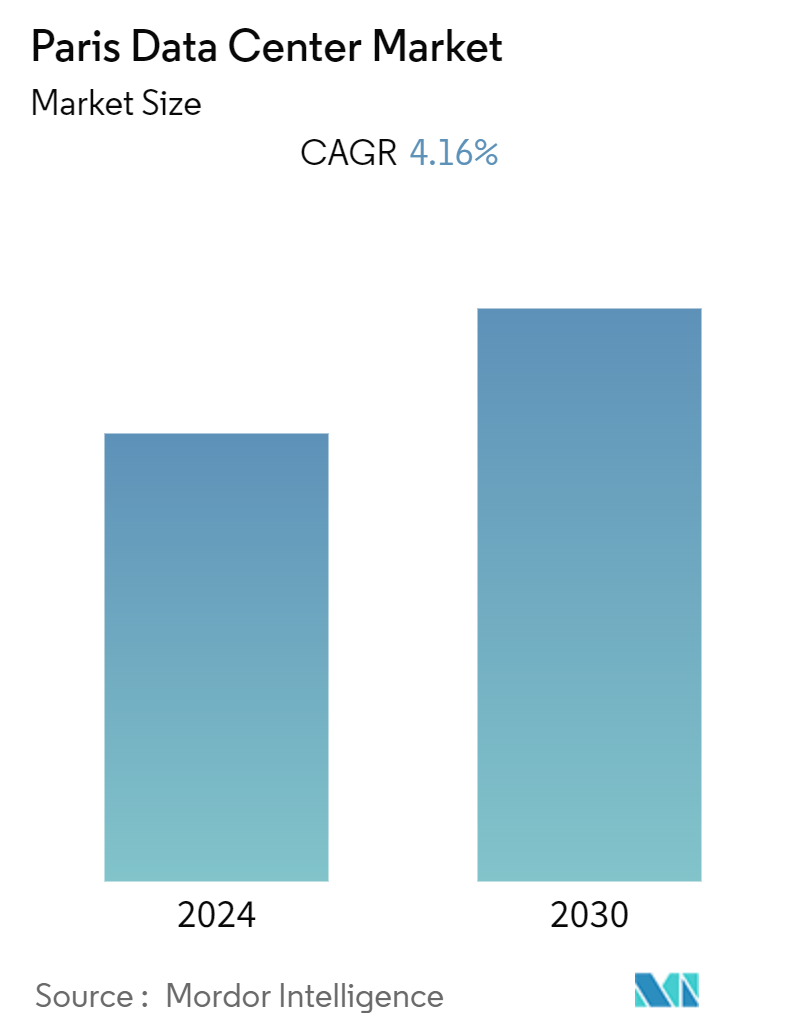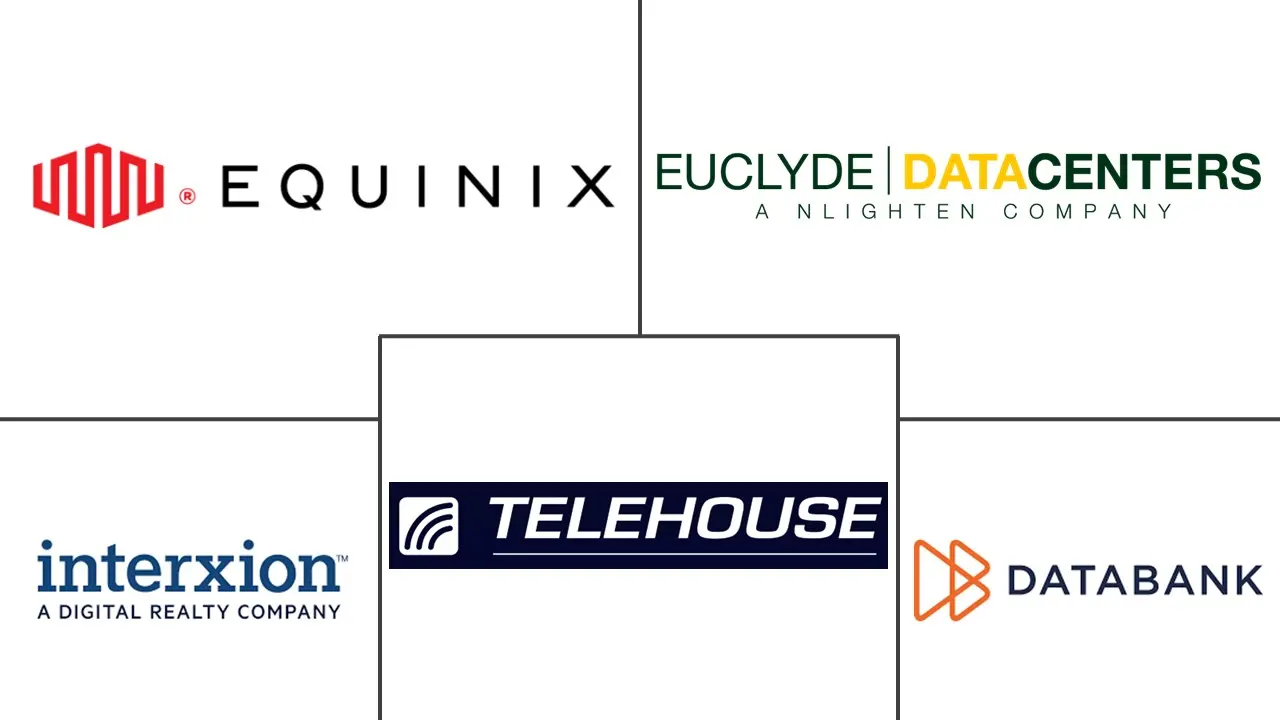Market Size of Paris Data Center Industry

| Study Period | 2019 - 2030 |
| Base Year For Estimation | 2023 |
| Forecast Data Period | 2024 - 2030 |
| Historical Data Period | 2019 - 2022 |
| CAGR (2024 - 2030) | 4.16 % |
| Market Concentration | Medium |
Major Players
*Disclaimer: Major Players sorted in no particular order |
Paris Data Center Market Analysis
The Paris Data Center Market is expected to register a CAGR of 4.16% during the forecast period.
The main drivers anticipated to drive the market expansion are the increasing demand for energy-efficient data centers, considerable investment by colocation service and managed service providers, and expanding hyperscale data center building. Additionally, the development of big data, cloud computing, and the Internet of Things (IoT) has made it possible for businesses to invest in new data centers to preserve business continuity.
- Additionally, industrial development is expected to prosper due to the rising need for security, operational efficiency, improved mobility, and bandwidth. Software-based data centers boost industry growth by providing a higher level of automation.
- Artificial intelligence (AI) with machine learning (ML) necessitates the development of brand-new data center infrastructure more than any other application. Artificial intelligence (AI) and machine learning (ML) may require three times the power density of traditional data processing, necessitating a revolution in data center architecture. This is also dependent on sophisticated cooling systems to support the larger output. The intense nature of AI and ML computations may also result in a significant dispersion of computational, memory, and storage resources among many processors in a computational cluster.
- Paris has various artificial intelligence applications, including healthcare, fashion, and sciences. For example, the Radiology Department in Groupe Hospitaller Cochin Broca Hôtel-Dieu - Université Paris Descartes uses artificial intelligence in thoracic imaging and lung cancer applications, such as detecting and segmenting pulmonary nodules. Moreover, at Paris Fashion Week, artificial intelligence machines were used to picture conceptual apparel in a showroom. Such a wide range of AI in various industries would drive the market's demand.
- Moreover, telcos will require more servers and low-latency connectivity alternatives as more individuals spend time online. The size and connectivity of hyperscale data centers will be required to handle rising demand. In 2023, services will continue to be delivered as a single service or set of services using various resources, including networks, devices, private and public cloud services, and cloud deployment and operation platforms. Public clouds have enormous processing capacity, whereas private clouds give more security and control.
- For instance, in June 2022, Oracle announced the launch of a second cloud region in France to provide public cloud services to businesses looking to modernize their operations. In addition to the Oracle Cloud Marseille area, the new La Courneuve, Paris region will provide Oracle's European customers and partners with access to a broad spectrum of cloud services with built-in security, disaster recovery, and industry-leading price performance. Oracle's one-of-a-kind dual-region cloud architecture allows French customers to deploy resilient applications in several geographical regions.
- On the flip side, development centers have conducted extensive research on energy efficiency in data centers, focusing on optimal QoS, efficient utilization of resources, and operation cost reduction. They aim to minimize brown energy utilization by proposing a load-balancing approach utilizing the available green energy. Load balancing is based on available renewable energy and has been installed in multiple data centers. A workload and energy management scheme was introduced to decrease the operational cost of the network and energy costs. Combined cooling, heating, and power (CCHP) systems also can reduce carbon emissions and air pollution and significantly increase resource energy efficiency.
- Moreover, coronavirus had a minimal influence over the Paris data center market as it is an essential infrastructure. Data centers remained open during the coronavirus-related shutdowns as the government deemed the operation and maintenance of data centers as a critical service. However, pricing came under pressure during the pandemic owing to macroeconomic slowdowns due to extended shutdowns and prolonged economic slowdowns in the country caused by the pandemic. The demand for data centers has seen a positive rise, augmented by technology demand growth due to shutdowns. Companies upgrading IT infrastructures to support remote working amid shutdowns may shift workloads to the public and private cloud.
Paris Data Center Industry Segmentation
A data center is a physical room, building, or facility that holds IT infrastructure used to construct, run, and provide applications and services and store and manage the data connected with those applications and services.
The Paris data center market is segmented by DC size (small, medium, large, massive, mega), tier type (tier 1 and 2, tier 3, and tier 4), absorption (utilized (colocation type (retail, wholescale, and hyperscale), end user (cloud and IT, telecom, media and entertainment, government, BFSI, manufacturing, and e-Commerce)), and non-utilized). The market sizes and forecasts are provided in terms of value (MW) for all the above segments.
| DC Size | |
| Small | |
| Medium | |
| Large | |
| Massive | |
| Mega |
| Tier Type | |
| Tier 1 & 2 | |
| Tier 3 | |
| Tier 4 |
| Absorption | |||||||||||||||||
| |||||||||||||||||
| Non-Utilized |
Paris Data Center Market Size Summary
The Paris Data Center Market is poised for growth, driven by the increasing demand for energy-efficient solutions and significant investments from colocation and managed service providers. The expansion of hyperscale data centers, alongside the burgeoning fields of big data, cloud computing, and the Internet of Things, is facilitating the establishment of new data centers to ensure business continuity. The rise of artificial intelligence and machine learning is particularly influential, as these technologies require advanced infrastructure and cooling systems due to their high power density and computational demands. The diverse applications of AI in sectors such as healthcare and fashion in Paris further stimulate market demand. Additionally, the need for enhanced security, operational efficiency, and low-latency connectivity is propelling the development of software-based data centers, which offer greater automation and resource optimization.
The market landscape is moderately consolidated, with key players like Equinix Inc., Digital Realty, and Euclyde Data Centers actively investing in strategic partnerships and infrastructure expansion. Recent developments include significant projects such as Data4's planned data center complex in Nozay and Telehouse's new facility at TH3 Paris Magny, both of which underscore the city's growing technological footprint. The BFSI sector's digital transformation, driven by the adoption of mobile banking and digital payment methods, is also a major contributor to the market's expansion, necessitating cost-effective and energy-efficient data center solutions. The ongoing advancements in digitization and cloud adoption are expected to further boost the demand for data center construction in Paris, positioning the city as a pivotal hub for data center operations in Europe.
Paris Data Center Market Size - Table of Contents
-
1. MARKET SEGMENTATION
-
1.1 DC Size
-
1.1.1 Small
-
1.1.2 Medium
-
1.1.3 Large
-
1.1.4 Massive
-
1.1.5 Mega
-
-
1.2 Tier Type
-
1.2.1 Tier 1 & 2
-
1.2.2 Tier 3
-
1.2.3 Tier 4
-
-
1.3 Absorption
-
1.3.1 Utilized
-
1.3.1.1 Colocation Type
-
1.3.1.1.1 Retail
-
1.3.1.1.2 Wholesale
-
1.3.1.1.3 Hyperscale
-
-
1.3.1.2 End User
-
1.3.1.2.1 Cloud & IT
-
1.3.1.2.2 Telecom
-
1.3.1.2.3 Media & Entertainment
-
1.3.1.2.4 Government
-
1.3.1.2.5 BFSI
-
1.3.1.2.6 Manufacturing
-
1.3.1.2.7 E-Commerce
-
1.3.1.2.8 Other End User
-
-
-
1.3.2 Non-Utilized
-
-
Paris Data Center Market Size FAQs
What is the current Paris Data Center Market size?
The Paris Data Center Market is projected to register a CAGR of 4.16% during the forecast period (2024-2030)
Who are the key players in Paris Data Center Market?
Equinix Inc., Digital Realty (Interxion), Euclyde Data Centers, Telehouse and Databank are the major companies operating in the Paris Data Center Market.

